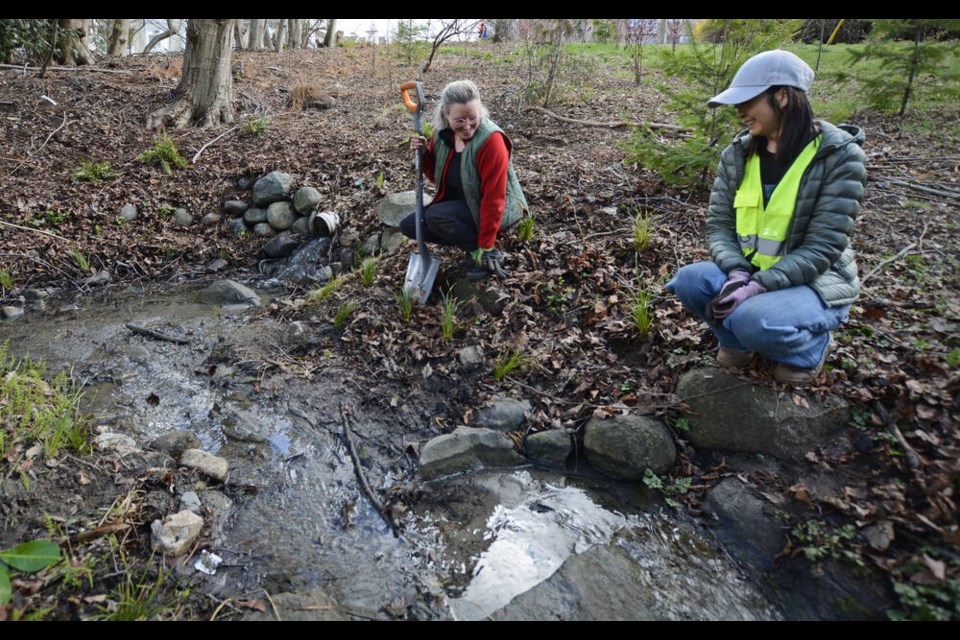Stormwater – the run-off from impervious urban surfaces like streets, sidewalks, parking lots, driveways, roofs and lawns – carries contaminants that are harmful to creatures that live in or rely on local waterways.
One such habitat in North Vancouver that’s particularly at risk is Wagg Creek, as an outfall pipe empties directly into it near 22nd Street West and Chesterfield Avenue.
But a new project to clear out invasive species, while bringing in native plants and structural improvements, is designed to help filter out harmful sediments and promote health in the area for years to come.
Last Saturday, members of North Shore Streamkeepers, City of Vancouver staff and around 25 volunteers gathered near the storm drain to install a rain garden, the third North Shore Rain Garden Project demonstration site in the city, following the first garden installed in 2019 near the Capilano Mall parking lot across from MacKay Creek, a significant salmon-bearing stream.
Project organizers note the strong relevance of projects like this on the North Shore, where watershed systems of rivers, streams and creeks – many home to salmon and other fish species – are fed by a combination of high levels of rainfall and melting snowpack. These factors contribute to flooding, erosion and damage to salmon habitat, especially as the urban landscape has less surfaces that absorb water. Ongoing industrial and residential spills also harm waterways.
Because of these pressures, Wagg Creek has been dominated by invasive species, says North Shore Streamkeepers vice-president Carolynne Robertson.
“A year ago, this entire bank was blackberry,” she said, pointing to a slope that had just been cleared and re-planted with native flora like mahonia, salmonberry and sword fern.
While invasives gobble up space and sunlight, native species are better at solidifying the soil, creating habitat for primary consumers like caterpillars and catching contaminants in the water itself.
Chloe Hartley of the North Shore Rain Garden Project – which is associated with Simon Fraser University – has been a part of the effort since it launched in 2019.
“A rain garden is built where there’s a storm drain, and you create a temporary detention pond – you just want to hold the water long enough for the sediment to settle out and the plants to absorb contaminants,” she explained. “They do an amazing job at that. We did some tests at the Capilano rain garden and 90 per cent of copper, lead, zinc, cadmium was intercepted from the parking lot into the rain garden.”
Green infrastructure, rewilding must be integrated into city planning, Streamkeeper says
A major concern for the Streamkeepers has been the Harry Jerome Neighbourhood Lands project, which flows directly out the Wagg Creek storm drain, Robertson said. The waterway went white with contaminants several times last fall, with one particularly bad spill in October.
Robertson said the site has been responsive to their concerns.
“They now have 12 storm water tanks, and a whole bunch of other stuff there to infiltrate what’s being pumped out of the ground,” she said.
According to a statement from the City of North Vancouver, the Harry Jerome Community Recreation Centre construction includes a professionally designed water quality treatment plant and has met all of requirements of the city’s bylaw relating to site sediment control.
“During a period of heavy rains in the fall (October to December) there were cloudy substances reported in Wagg Creek and the HJCRC was one of many sites draining to that catchment,” reads the statement. “Due to the scale of excavation at that time steps were taken to increase the capacity of the water quality treatment plant.
“Sadly spills do occur within our waterways and when reported to the city, staff immediately attend and take efforts to contain or mitigate the impacts on the creek and to trace the source of the spill by tracking the contamination upstream through the drainage system.”
The city said it continues to monitor the changing site conditions to ensure that only clean water is leaving the site.
While bylaws are designed to strengthen water quality requirements for developers, Robertson said that’s not enough.
“It’s completely not enough, because we’re in a situation where there’s been so much historical damage to our ecosystems that we need to do above and beyond that,” she said.
“Every time a sewer line is replaced, roadwork is done, maybe a right of way is redone is an opportunity to look at that and see how green infrastructure can be incorporated.” Robertson added. “It’s critical that green infrastructure, rewilding and claiming some of our natural spaces back is tightly integrated into planning. I’m really hoping the work today will shine a light on that.”




